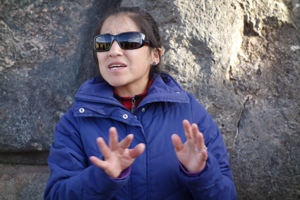First, how about them Giants, huh? Quite a story. And just another sign of how small the world is; in Cuzco, Peru, I was following along pitch by pitch on MLB Gameday and texting comments back and forth with Anne at the same time. I don’t expect them to beat Detroit, mostly because of Verlander, but you sure can’t bet against them after what we’ve seen the last two weeks. Go Giants!
I’m going to break with the daily format here and write about all the visits to inca sites over the past three days. What an impressive people! The architecture, of course, I think most people are familiar with, but there were many other aspects of their culture; there was a real sense of nationhood, and the nation was linked together by roads, customs, and trade. Having been in Bolivia, first, at one of the outlying posts on the Isla del Sol gave an interesting perspective, as the construction there, while less monumental, was every bit as detailed and careful. Isla del Sol had a pier, and was linked by water the north shore of Lake Titicaca and then to the capital at Cuzco.
There are outposts along the roads, agricultural settlements in many places. . . Lots of evidence of a thriving culture. And it wasn’t that long ago; the empire lasted for only 300 years and ended with the arrival of the Spanish in the 1540’s. It’s evident that the Inca built on the foundation of the cultures that preceded them. Our guide explained a lot about the culture and religion; I was struck by some similarities to Temple Judaism; animal sacrifice, agricultural based holidays, practices of purification and abstention among priests around big events, voluntary tithing but also the recruitment and development of major donors. The Inca imbued mountains and other natural features with Godly power. I was particularly struck by the similarity of the lengthy names of some of these mountains with the actual text of some of our prayers. I’m sorry I didn’t write down an example, but it was a bit uncanny.
We’ve done some pretty intense bus touring the past three days and hace barely scratched the surface at five Inca sites (although we did spend a good chunk of time at Mâchu Picchu). There are about fifteen of us on this portion of the trip, 11 gringos and 4 locals. Our tour guide is Olga, who Lon has used previously. Olga was born in Abancay, in poverty. She has six siblings. Her father died. Her mother had to give her up to an aunt to raise, but her mother was quite specific about Olga bettering her life. Although her oldest sister is popping out the babies, Olga is the first woman in her family to have a career. We were her last tour group, as she is marrying Puerto Rican and moving there in a couple weeks. In a personal conversation, she spoke about endemic sexism as well as the historic discrimination against Andean people, which has finally been changing with the election of two Presidents of Andean descent over the past few years. She is after her own betterment, but also is conscious of herself as a pioneer for Andean women.
Sacsayhuaman is actually in Cusco. The Inca fashioned the City in the shape of a Puma with Sacsayhuaman as its head. It is dominated by these monumental defensive walls of carefully shaped but massive stones, each individually shaped and polished to fit to its neighbor while the structure as a whole is also fit to its site and built with both integrity and aesthetics in mind. Unfortunately due to time constraints we did not get to fully explore the site as we had to move on to the next agenda item, dinner at Clara’s house, which I’ll write about in a different post.
href=”http://www.markgunther.net/wp-content/uploads/2012/10/20121023-1102321.jpg”>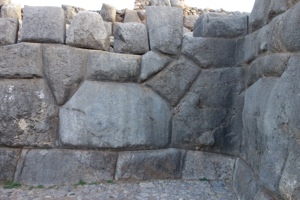
Stonework in the wall in the shape of a llama.
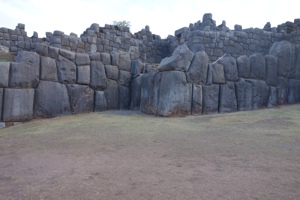
Three layers of walls leading up to the buildings on top.
The next morning we left Cusco and visited three sites, ending up on the train to Aguas Caliente, the access point to Mâchu Picchu. First up, at the end of a long dirt road that dove precipitately into the canyon, were the ‘salt mines,’ actually evaporation ponds, created by the inca and, although no longer economically viable, operated today by families in much the same way as then. Each pond turns over seven times a year, yielding 1400 kilos of salt for which they can get maybe fifty soles a kilo. So it’s sold to tourists at the site.
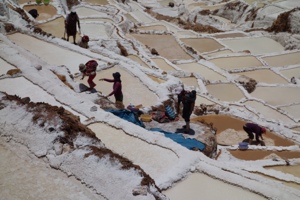
A family working their evaporation pond.
We then visited the fascinating Inca agricultural laboratory at Moray. Check this out:
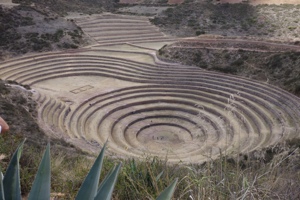
It’s huge. See the people at the bottom?
So the theory is that each level had a different microclimate. A potato would be planted at the bottom. At maturity, it would be harvested and replanted, then hybridized and moved to the next level. Repeating this process enough would yield hybrids customized for each specific microclimate (Peru is the home of the potato; they have 4300 varieties). Not only is that cool, but some scientist had to sell the Inca king on it, and the king had to both understand the PowerPoint and the economic implications enough to make this kind of a massive infrastructure investment (Are you listening, Mitt?). A digression; according to Olga, this was not built by slaves, but by either 1) indentures, or 2) loyal subjects giving freely to the effort, or 3) voluntary laborers who received something in barter for their labor. Of course, no one really knows how it operated in practice, but its certainly a different model than ours!
After lunch at a giant buffet restaurant in Urubamba, we we’re off to Ollantaytambo, characterized as the last Inca city. Many Inca walls remaining, houses built in the Inca style, narrow streets, the Inca water systems still in use. Kind of felt like Williamsburg. Or Sherburne Village. The valley leading up to town was generously terraced; the short hairpin bend in the Inca stone road followed the Inca wall; the temple was perched high above the City as were the granaries so they could be exposed to the prevailing wind to cool and dry the grain.
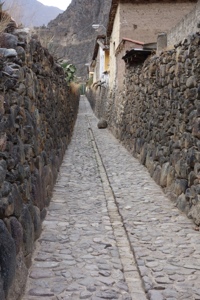
A typical street in Ollantaytambo.
Of course, we couldn’t spend enough time there as we had to catch a train, the only access to Aguas Caliente, which exists solely to serve the 3300 people per day who visit Mâchu Picchu. Which certainly lives up to, no, exceeds its billing. First off is the setting. Sitting on its own ridge overlooking the Urubamba Rive, it’s is surrounded on all sides by progressively higher peaks. At 7,900 feet it is at the top of the vegetation zone, but surrounded by rocky faces and snow capped peaks in the middle distance.

Maybe this 120 degree panorama can give you a bit of the sense of it. That’s Mâchu Picchu on the far left and the sun gate on the far right.
Eight of us got on the shuttle at 5:30 in the morning to join the hordes thronging to the site. after shouldering our way through the gate, we began the hour long hike to the Sun Gate (thanks, Dan) and soon were enveloped in the quiet majesty of the mountains. It was a steady uphill, and, covered with sweat, we got to the top shortly after sunrise, where about 75 people were hanging out–three or four groups of Inca trail hikers. Just the short walk along the well developed trail again reinforces the sense of an Inca nation.
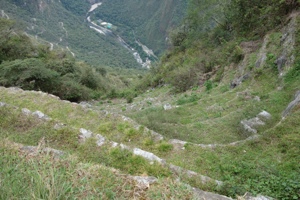
Retaining walls supporting the Inca trail at the Sun gate. That’s the Urubamba 2,000 feet below.
Walking back down the trail we met Olga and the rest of the group at 8:30 and spent the next three hours exploring the site. It is incredibly well preserved–temples, homes, palaces, granaries, the quarry, agricultural terraces, its all there. The site delivers a very strong sense of how life was lived by the upper classes; as best as anyone can tell, MP was both a religious site and a getaway for the king. Olga was full of stories of the significance of each little thing and this was fully integrated with her knowledge of Inca culture. Her first language is Quechua and the resonance of the words as they rolled off her tongue made the stone come alive. There still is active archaeology going on there. I was continually reminded of Jerusalem, and tried to asked a couple of the Peruvian women how they felt being there. Alessandra, who is from the jungle, felt proud and excited, but didn’t seem to have a personal sense of awe; Olga thought about it as a representation of the place of the mountain people’s in Peruvian society, but neither seemed to have that roots feeling that Jerusalem gave me. If you want a Mâchu Picchu travelogue, go read a book or come to my slide show; here’s a couple more photos.
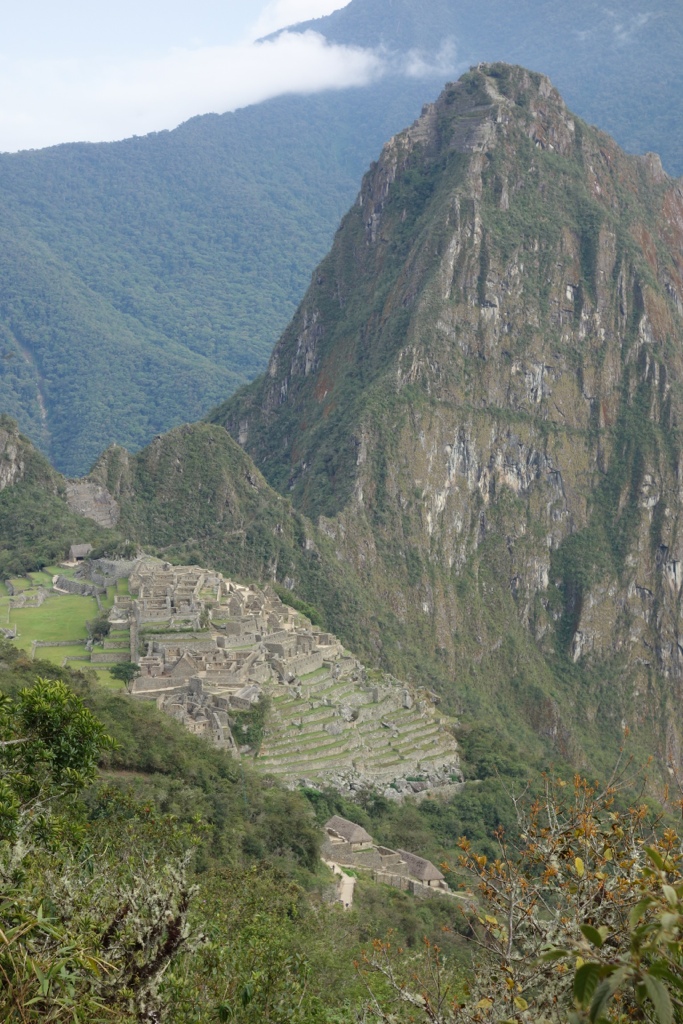
I’m sure you’ve seen this before, but how could I resist? There still is about a third of the site out of the photo to the left
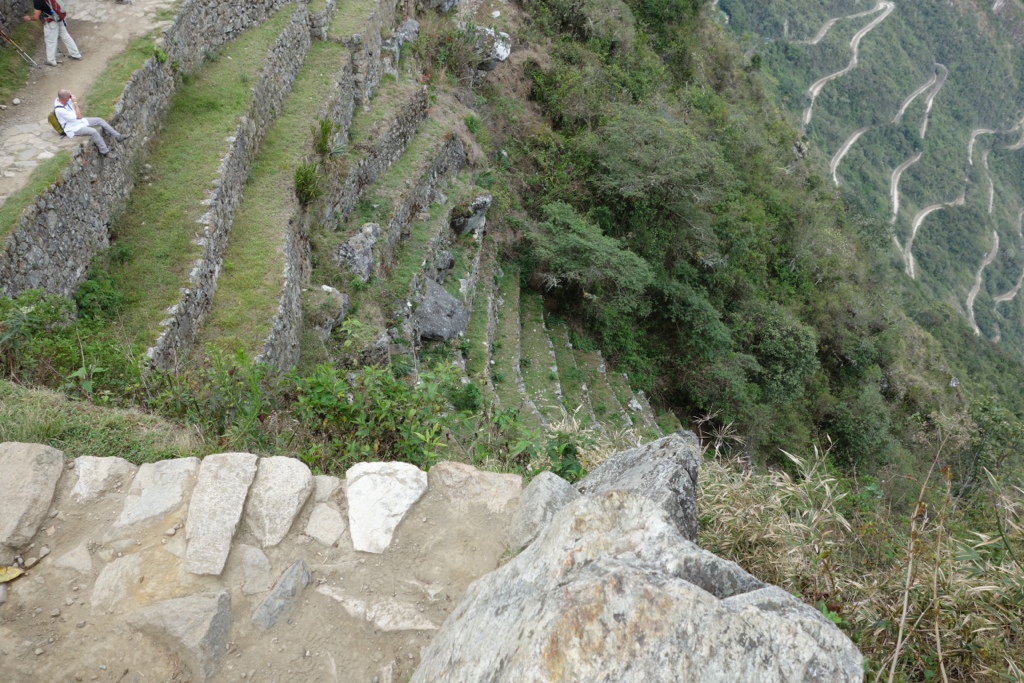
Sun gate, retaining walls, and access road in the distance.
Love those Incas. They will see me again. Thanks for reading!

